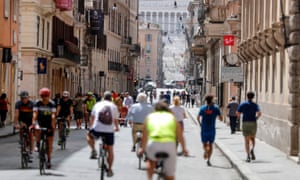Saint Peter’s Basilica in the Vatican has reopened to visitors after being closed for over two months under Italy’s lockdown orders to prevent the spread of the coronavirus.
A handful of visitors queued up, observing social distancing rules, and were watched by police officers wearing face masks before having their temperatures taken to enter the church, which has been closed since 10 March.
Nuns visit St Peter’s Basilica as it reopened on Monday. Photograph: Vincenzo Pinto/AFP via Getty Images
Italy was the first country to go into a full lockdown over two months ago, bringing the economy to its knees.
The official death toll from the virus in the country now stands at around 32,000.
The government started lifting restrictions on 4 May, and on Sunday joggers, walkers and cyclists were plentiful on the streets of Rome’s historic centre.
Daily life during phase two of the Covid-19 emergency in the centre of Rome, Italy. Photograph: Riccardo Antimiani/EPA
Restaurants, bars, cafes, shops and hairdressers, among other businesses, were all expected to reopen on Monday, with public masses also resuming.
Coronavirus brought Belgium its deadliest April since the second world war, according to a study, as the country begins slowly to lift lockdown measures.
A total of 14,790 people died in Belgium last month as Covid-19 swept the country – substantially higher than the normal April total of deaths below 9,000, researchers from the Vrije Universiteit Brussel (VUB) found.
Not since the Nazi occupation of the 1940s has Belgium had such a high mortality rate in April, the month when high winter death rates usually drop off with the onset of spring, the researchers found.
“Mortality in Belgium is exceptionally high, reaching unprecedented levels, especially in the period from 1 to 12 April,” the university said in a statement.
There were 639 deaths on 10 April, “more than double the number that would have been expected for that day”. It said:
April 2020 was the deadliest April since the Second World War, both in absolute numbers and per capita.
Belgium has been hit hard by the pandemic, suffering one of the world’s highest per capita death tolls, though the virus appears to be easing and lockdown restrictions are starting to be lifted, AFP reports.
The government has also been praised by the World Health Organization for keeping more accurate tolls than some of its neighbours, and the per capita rate may be higher because of this.
Southern European countries ease lockdowns. Italy is reopening bars, cafes, restaurants and hairdressers - with social distancing measures in place - for the first time since its lockdown began. Meanwhile in Spain, almost three quarters of the country progressed to the second phase of its lockdown de-escalation, allowing millions of people to meet up in groups of up to 10, and to have a drink or a meal on cafe and restaurant terraces.
Global infections pass 4.7 million. There are 4,727,625 confirmed cases of coronavirus worldwide. At least 315,482 people have died over the course of the pandemic. The number of deaths in the US is approaching 90,000, with 89,564 confirmed fatalities and 1,486,742 infections, according to the Johns Hopkins University tracker.
Japan falls into recession. Japan dived into its first recession since 2015, according to official data on Monday, with the world’s third-largest economy contracting by 0.9% in the first quarter as it wrestled with the fallout from the coronavirus.
South Africa reports highest daily increase in cases. It reported 1,160 new coronavirus infections, the highest daily number since the first case was recorded in March. The Western Cape province, popular with tourists, accounted for nearly 60% of the national numbers.
New virus cases in Russia under 9,000 for first time since 1 May. 8,926 new infections were recorded in the last 24 hours, as anti-virus restrictions ease and officials say the situation is stabilising.
Mayor of São Paulo, Brazil, says hospitals ‘near collapse’. The BBC has reported that the mayor of São Paulo, the country’s largest city, has warned that hospitals have reached 90% capacity and are “near collapse”. They could run out of space in two weeks’ time, he said. Brazil has the fourth-highest number of infections worldwide, with 241,080, according to Johns Hopkins University figures. It has recorded 16,118 deaths.
Meanwhile, Brazilian president Jair Bolsonaro greeted hundreds of supporters who gathered before the presidential offices Sunday and joined some in a series of push-ups .
Taiwan blocked from WHO meeting following Chinese pressure. Taiwan had been lobbying to take part in the World Health Assembly, which opens later on Monday, but did not get invited due to Chinese pressure, its foreign minister said, adding they had agreed to put the issue off until later this year.
Thailand’s economy contracts for first time since 2014. The coronavirus pandemic, which has shuttered borders and devastated the tourism-reliant country, caused the economy to shrink for the first time in six years.
Ryanair chief accuses UK of mismanaging coronavirus crisis. Michael O’Leary described the UK’s planned introduction of a 14-day quarantine period for travellers arriving from abroad as “idiotic and unimplementable”.

